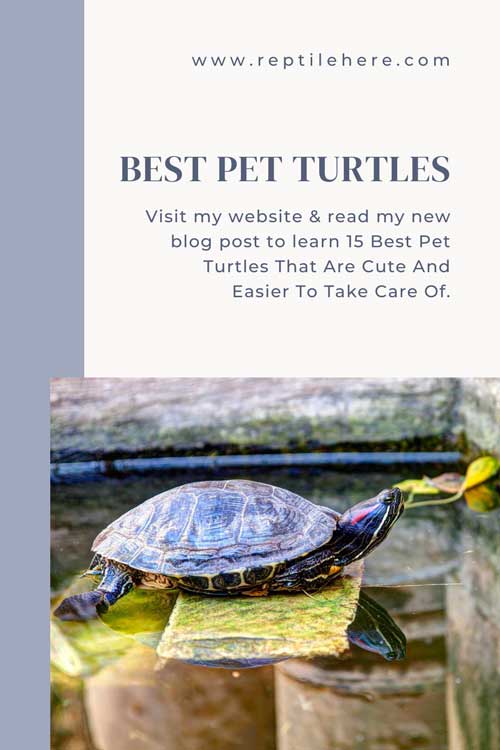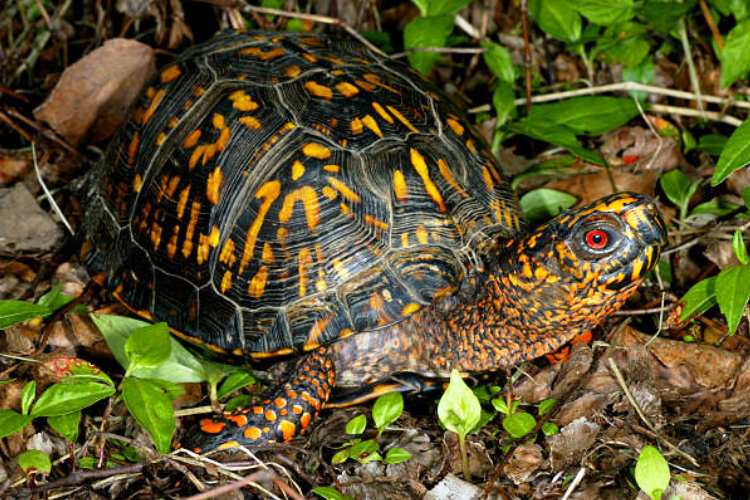15 Best Pet Turtles That Are Cute And Easier To Take Care Of
There are many species of turtles available today, but not all of them can be kept as pets. Some are endangered and illegal to own while others are aggressive. Yet, some can grow into too big sizes which makes it hard to domesticate them.
Moreover, everyone has their own preferences when it comes to pet turtles.
That said, most people will always settle for species that have a unique coloring that make them look cute and don’t demand a lot in terms of maintenance.
We have compared the various types of turtles and come up with the following list of the top 15 turtles that look cute and appealing and at the same time are easier to take care of.
Let’s get into the details right away…
1. Red-Eared Slider
Contents
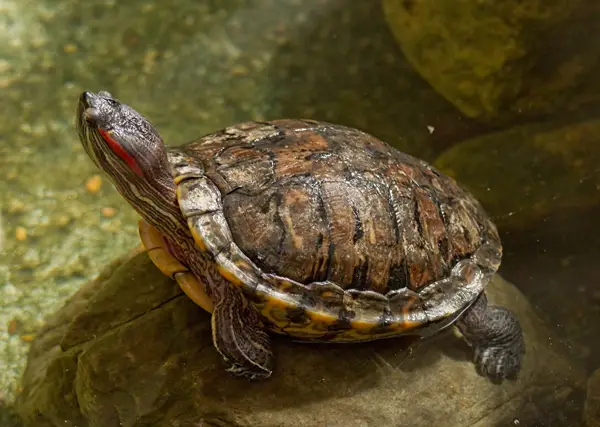
- Scientific name: Trachemys scripta
- Common name: Red-eared Slider, Red-eared Terrapin
- Family: Emydidae
- Size: 7 to 11 inches
- Lifespan: 30 to 40 years
- Conservation status: Least Concern
The red-eared slider is one of the most popular turtle pets across all the states in the US. This turtle is widely available and more sociable and friendlier compared to other turtle species.
It is a semi-aquatic turtle and is generally housed indoors. Hoverer, it can also do well outdoors if provided with the right shelter, warmer temperatures, and cleaning.
A red-eared slider gets its name from the small red stripe surrounding its ears (or behind the eye), and its ability to quickly slide off logs and rocks into the water.
Generally, the skin and shell coloration of this slider can be brown or black, with yellow stripes covering the skin.
The red-eared sliders are pretty large and the adults reach 7-12 in length (though females are generally larger than males).
These pond sliders are omnivorous and like eating fish, snails, insects, and aquatic vegetation. They also eat land vegetation, including fruits and vegetables.
With good care, a red-eared slider can be a hardy and healthy pet turtle that will hit up to 40 years. Some even go up to 50 years!
2. Yellow-Bellied Slider
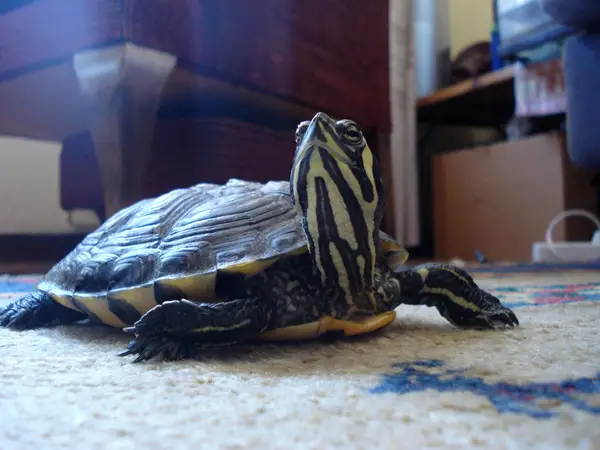
- Scientific name: Trachemys scripta scripta
- Common name: Yellow-bellied slider
- Family: Emydidae
- Size: 8 to 13 inches (females), 5 to 9 inches (males)
- Lifespan: 30 to 40 years
- Conservation status: Least Concern
The yellow-bellied slider turtle is a popular choice of a pet turtle for most folks. It doesn’t require a lot of special care and has eye-pleasing looks which many people fall in love with.
It is a semi-aquatic turtle that lives in water as well as on land. And it can be found in a variety of habitats including floodplain swamps slow-moving rivers, seasonal wetlands, marshes, and even permanent ponds.
As the name suggests, this pond slider features a yellowish plastron. Plus, it bears yellowish markings on its skin, not to forget prominent yellow stripes behind its eyes. The upper shell color ranges from dark brown to olive.
These sliders are omnivorous and like eating fish, snails, insects, and aquatic vegetation. they also eat land vegetation, including fruits and vegetables.
3. African Sideneck Turtle
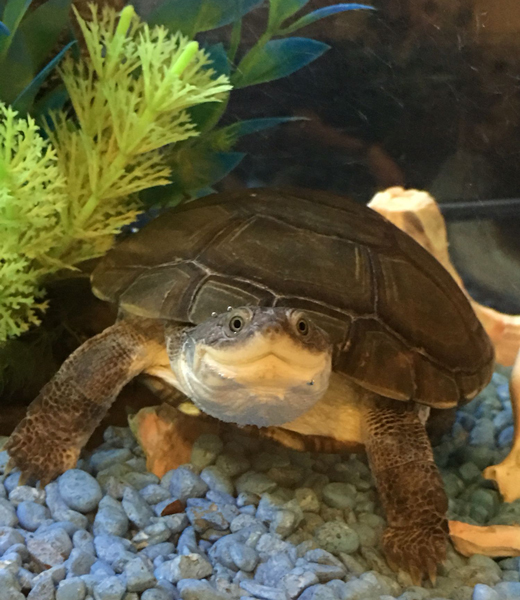
- Scientific name: Pelusios castaneus
- Common name: African Sideneck turtle, African mud turtle, African aquatic Sideneck turtle
- Family: Pelomedusidae
- Size: 7 to 11 inches
- Lifespan: 25 to 50 years
- Conservation status: Not extinct
A long neck that doesn’t fully retract into the shell is one of the distinctive features of this turtle that sets it from its relatives. Besides, it has a cute little smiling face and its shell looks similar to that of a land turtle.
All these unique features plus the appearance make the African Sideneck turtle a popular choice of pet for many folks.
The turtles are small (with an adult averaging between 7 and 11 inches) and can live for several decades (between 20 and 50 years)
Diet for these turtles is also different from that of other turtles. It will eat meat such as cooked chicken, fish, and beef heart.
Also, you can feed it greens like romaine lettuce and collard greens. You can also feed it commercial turtle food. The adults usually prefer leafy green veggies.
On top of all this, the turtle is easy to care for. And yes, it doesn’t hibernate like the American turtle species; it stays active all year round. However, this turtle is less common to find than American native turtles.
4. Pink Belly Sideneck Turtle
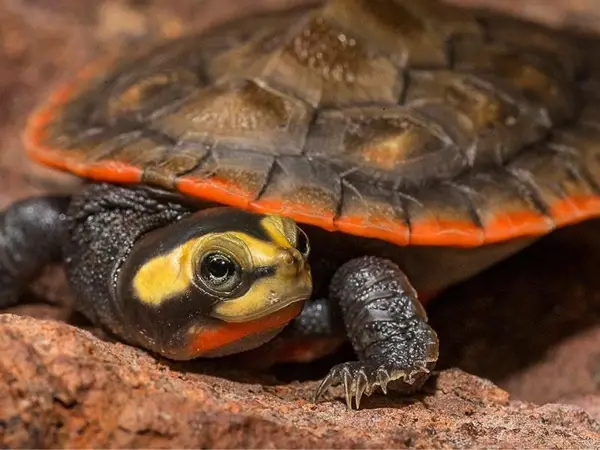
- Scientific name: Emydura subglobosa
- Common name: Pink belly Sideneck turtle
- Family: Chelidae
- Size: 8 to 9 inches
- Lifespan: 30 to 50 years
- Conservation status: Least Concern
The pink-bellied Sideneck turtle is a good turtle for beginners as well as experienced turtle owners. The cute and unique looks make it a popular choice in the turtle pet market.
This turtle has a black shell that contrasts with a bright orange-pink underside. Its black head is usually covered with cute yellow eye markings.
Its natural habitat is tropical areas featuring large sources of freshwater, including swamps, ponds, and lakes in Australia and Papua New Guinea.
When it comes to housing needs, this turtle requires a 20 to 60-gallon tank with brackish or fresh water and a gradient temperature of 66 to 95 degrees F. Its tank should also be furnished with aquatic vegetation and logs/slopes.
Pink belly Sideneck turtle is generally omnivorous and likes feeding on aquatic insects, mollusks, crustaceans, sponges, and algae.
In captivity, this turtle can live for 30 to 50 years when provided with good housing conditions and fed a healthy diet.
5. Diamondback Terrapin
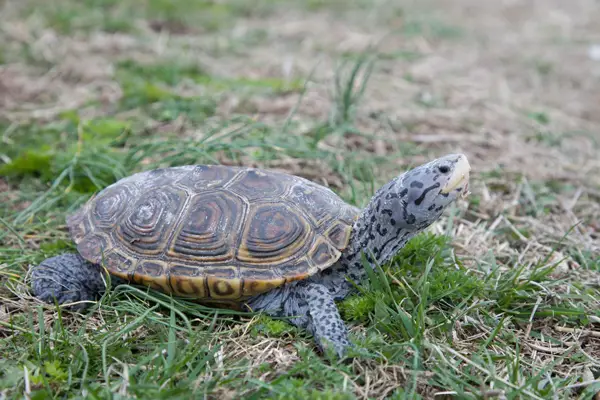
- Scientific name: Malaclemys terrapin
- Common name: Diamondback Terrapin
- Family: Emydidae
- Size: 4 to 6 inches (males), 5 to 8 inches (females)
- Lifespan: 25 to 35 years
- Conservation status: Vulnerable
The diamondback terrapin shell has a raised diamond shape, hence the name diamondback. The term “terrapin” simply means little turtle.
A typical diamondback terrapin has a black-to-brown carapace and yellow lower shell that may sometimes feature dark-colored patterns. The turtle’s skin is usually grey-white with multiple small black spots.
Female diamondback terrapins are usually bigger than their male counterparts.
These turtles are highly timid and can easily get stressed when in captivity. They’re pretty docile and can be handled easily. However, they’re known to bite as a way of defending themselves if they feel threatened.
Diamondback terrapins can be found along the coast in tidal flats, salt marshes, barrier beaches, and brackish streams. They can also stay in full-strength saltwater for longer periods of time.
The terrapins are largely carnivorous and feed on crustaceans, fish, crabs, shrimps, marine snails, marine worms, mollusks, mussels, clams, and barnacles. However, they also tend to occasionally ingest small amounts of plant matter.
6. Western Painted Turtle
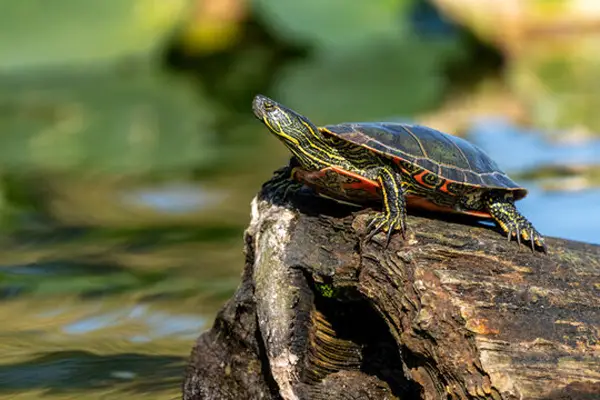
- Scientific name: Chrysemys picta belli
- Common name: Westland Painted Turtle
- Family: Emydidae
- Size: 4 to 10 inches
- Lifespan: 30 to 40 years
- Conservation status: Least Concern
The Western Painted Turtle is identified by an oval-shaped carapace that lacks a ridge in the middle. The carapace is usually dark olive or black in color.
The lower side of the shell is usually red, with multiple dark markings in the center. And the skin itself is covered with yellow stripes.
Westland painted turtles are aquatic and their webbed feet help propel them in the waters.
The most common habitats for this turtle include slow-moving rivers, shallow streams, and lakes. They choose these areas because they can easily find food.
When in captivity, this turtle requires similar housing needs to the red-eared slider. it can also be quite shy, so you want to keep handling minimal.
Given that they’re omnivorous, they feed on aquatic vegetation as well as meat from insects, snails, shrimps, tadpoles, and earthworms. Their hatchlings are more carnivorous to help take in more proteins for building muscle.
7. False Map Turtle
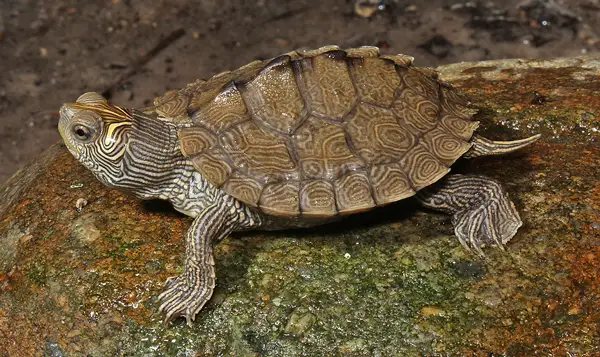
- Scientific name: Graptemys pseudogeographica
- Common name: False Map Turtle, Sawback Turtle
- Family: Emydidae
- Size: 6 to 10 inches (females), 3.5 to 6 inches (males)
- Lifespan: 30 to 50 years
- Conservation status: Least Concern
The False map turtle is cute and a popular choice of a pet turtle for many folks. Its upper shell coloring ranges from olive to dark brown, with light-colored lines on its limbs.
It also features a line behind its eye that forms a backward “L” shape. The map pattern on its carapace tends to fade as the turtle ages.
Since this map turtle is omnivorous, it feeds on aquatic insects and animals as well as vegetation. It is fond of river snails and crustaceans. Don’t forget it has strong jaws and can give a nasty bite!
Like other aquatic turtles, this map turtle spends most of its waking hours sunning.
The false map turtle is quite shy and quietly and swiftly slides into the water at the slightest signs of disturbance.
It likes spending most of its time in water and is most active in climate conditions of over 85 degrees Fahrenheit.
8. Mississippi Map Turtle
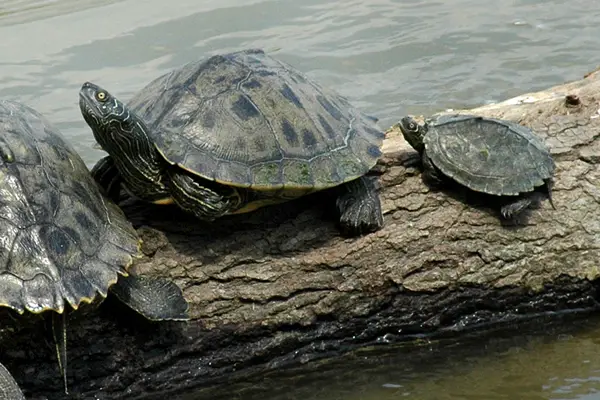
- Scientific name: Graptemys pseudogeographica kohni
- Common name: Mississippi Map Turtle, Sawback turtle
- Family: Emydidae
- Size: 3 to 10 inches
- Lifespan: 30 to 50 years
- Conservation status: Least Concern
The False map turtle is another turtle species you can keep as a pet. Its preferred habitat includes rivers, streams, and oxbow lakes of the Missouri and Mississippi and other river systems.
Captive species require small enclosures compared to some other turtle pets. And this makes them an appealing choice for people with space issues.
Its upper shell coloring ranges from olive to dark brown, with light-colored lines on its limbs. It also features a line behind its eye that forms a backward “L” shape. The map pattern on its carapace tends to fade as the turtle ages.
Since this map turtle is omnivorous, it feeds on aquatic insects and animals as well as vegetation. It is fond of river snails and crustaceans. Don’t forget it has strong jaws and can give a nasty bite!
Note that this turtle tends to be more worried about people than other turtles. it’s, therefore, prone to stress and you should minimize handling and give them an environment with hiding spots and less hymn traffic.
9. Common Musk Turtle
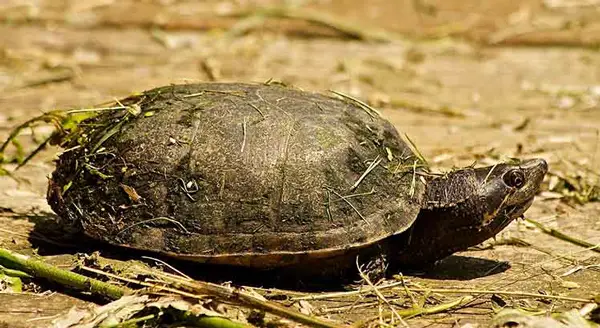
- Scientific name: Sternotherus odoratus
- Common name: Eastern Musk Turtle, Common Musk Turtle, Musk Turtle, Stinkpot
- Family: Kinosternidae
- Size: 2 to 4.5 inches
- Lifespan: 30 to 50 years
- Conservation status: Least Concern
The Common Musk Turtle is a pretty small turtle whose care requirements are pretty simple. This makes it one of the most popular choices for pet turtles across many states.
An average adult eastern musk turtle is quite small (2 to 4.5 inches long). It has a pretty plain appearance with highly consistent colors. Both the shell and skin usually share the same color and can range from dark brown to black.
The turtle shell has one unique feature—a ridge traversing its entire shell length. Besides, it has another distinctive feature: two light-colored stripes on its head.
Common musk turtles are omnivorous and will eat small aquatic or semi-aquatic animals, carrion, and aquatic vegetation. They will also feed on any other vegetation on land.
When it feels threatened, this turtle species emits a foul odor (a musky odor, hence its name). This scent can be detected in water or on land. It can also easily waft through the air to its predators.
Since this turtle isn’t a good swimmer, you should ensure the water in its enclosure isn’t too deep. You should also provide it with plenty of areas to get out of the waters for sunning or basking under the UVB light source.
10. Razor-Backed Musk Turtle
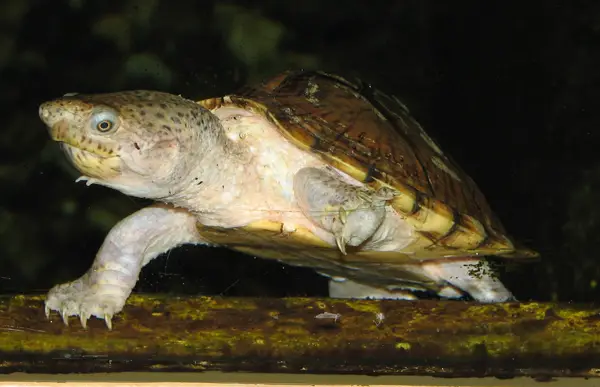
- Scientific name: Sternotherus carinatus
- Common name: Musk turtle, stinkpot
- Family: Kinosternidae
- Size: 5 to 6 inches
- Lifespan: 40 to 50 years
- Conservation status: Least Concern
The razor-backed must turtle is identified by the keels on its back. In other words, its carapace is shaped like a tent that comes to a point along its spine and then slopes down on its sides.
Just like the other must turtles, this species is also pretty small and the average adult hits 5-6 inches in length. Their shell color ranges from light grey to olive, brown, and black.
Skin color can be olive or dark brown, though the exact color differs from individual to individual.
These turtles usually have long necks and large heads which usually have bright colors and turn gray with dark spots as they age.
This razor-back musk turtle prefers living in water almost entirely and will only leave the waters to bask or when it’s time to lay eggs.
In the wild, the species live in deep waters of oxbow lakes and river swamps. They also prefer living in slow-current large streams.
Diet-wise, the razor-back musk turtle is mainly carnivorous and is fond of mollusks, snails, and fish.
11. Spotted Turtle
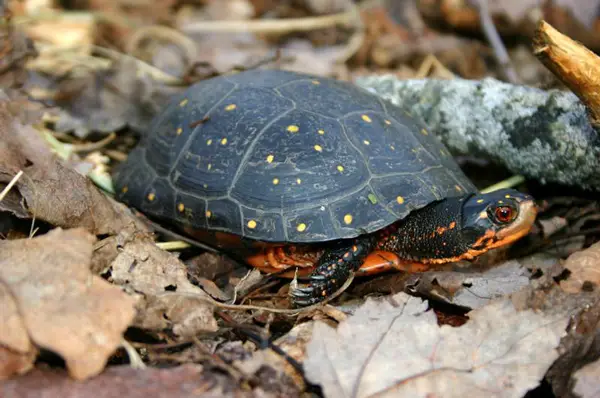
- Scientific name: Clemmys guttata
- Common name: Spotted Turtle
- Family: Emydidae
- Size: 4 to 5 inches
- Lifespan: 25 to 50 years
- Conservation status: Endangered
Spotted turtle is semi-aquatic and can live indoors or outdoors when provided with the right housing. The turtle is pretty small and is a great choice if you have limited space
An adult spotted turtle has a smooth upper shell that ranges from olive to dark brown in color, with some light yellow spots. The neck and head feature irregular orange or yellow spots and streaks. Their tails are fairly long.
The turtles are omnivorous and their diet involves crustaceans, mollusks, insects, and plant matter (occasionally). Note that these turtles are aggressive hunters and will actively seek their prey.
Unfortunately, the population of spotted turtles is on the decline due to human interference and habitat loss. Their unique shell patterns make them a favorite species of pet turtle for many people.
For this reason, they’re listed as endangered and protected by many governing bodies across various states.
Above all, spotted turtles are incredibly smart. Studies carried on them using a maze even indicate that they have the same brain capacity as the mouse!
12. Reeve’s Turtle
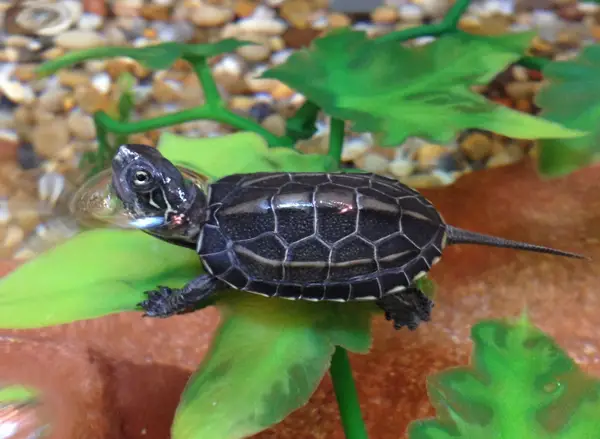
- Scientific name: Mauremys reevesii
- Common name: Reeve’s Turtle, Chinese three-keeled pond turtle, Chinese pond turtle
- Family: Geoemydidae
- Size: 6 to 9 inches
- Lifespan: 10 to 20 years
- Conservation status: Endangered species
The Reeve’s turtle is also known as the Chinese pond turtle as it inhabits China and its range extends towards north and south Korea, Japan, and Taiwan. They usually inhabit small streams, lakes, and ponds.
The turtle mostly has a plain look but has a few distinctions that make it easily identifiable from other species of turtles. Its shell features 3 longitudinal keels with colors ranging from olive green to black to tan.
We feature the turtle on this list because it’s quite hardy to keep as a pet and requires a simple diet.
However, keep in mind that this aquatic turtle isn’t a good swimmer, so you should be careful with the water levels in its enclosures. As a general rule, the water depth should be 1½ the turtle shell length.
Remember, this turtle has a lifespan of up to 20 years with proper care, diet, and housing—making it a longtime companion for you. Their adult size is 6-9 inches, which is easy to manage for all pet owners.
13. Wood Turtle
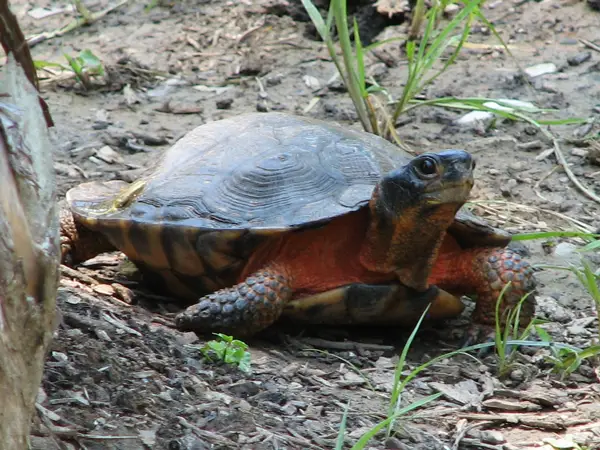
- Scientific name: Glyptemys insculpta
- Common name: Wood turtle, Sculptured Tortoise, Redleg, Red-legged Tortoise
- Family: Emydidae
- Size: 5.5 to 8 inches
- Lifespan: 40 to 60 years
- Conservation status: Endangered
Wood turtle species is a good choice for an outdoor pet turtle. It is easy to care for and will require just an average size tank enclosure.
It is also known to be quite friendly with the right interaction and handling.
In the wild, wood turtles tend to stay near the water and will frequently venture into it. During winter, they tend to hibernate at the bottom of deep rivers and pools.
The turtles get their name from their sculpted-like looks. Their upper shells are dark brown and have sport patterns resembling wood grain and growth rings.
Their scutes may sometimes appear like they’re pyramiding, further enhancing their sculpted shape.
Wood turtles are diurnal omnivores and their diet mainly consists of berries, leafy greens, insects, and mollusks.
They forage for their food widely and have even been observed stomping their feet on the ground as a way of tricking the earthworms into surfacing.
Unfortunately, these turtles are less common and maybe even illegal to own in some states. When looking for one, be sure to research to ensure you get one from a reputable breeder.
14. Bog Turtle

- Scientific name: Glyptemys muhlenbergii
- Common name: Bog Turtle, Muhlenberg’s turtle
- Family: Emydidae
- Size: 3.5 to 5 inches
- Lifespan: up to 40 years
- Conservation status: Critically Endangered
The Bog turtle is the smallest aquatic turtle you’ll find in North America. The species is critically endangered and is one of the rarest turtles in many states.
Adult bog averages between 3 and 5 inches (quite small, right?). The turtle’s carapace coloration ranges from black to olive or dark brown and features a central keel ridge—making it one of the cutest turtles available.
Some of the scutes making up their upper shell may also bear red or yellow-star markings. And their heads have distinctive orange or yellow patches.
The bog turtle will need an enclosure that’s half land and half water to live comfortably. It is easy to maintain and quite hardy, making it a good choice for beginner pet owners.
Its diet is pretty similar to that of other species. In the wild, it is mainly a diurnal omnivore and likes eating insects, mollusks, and occasional vegetation. It is most active during warm parts of the day.
15. Eastern Box Turtle
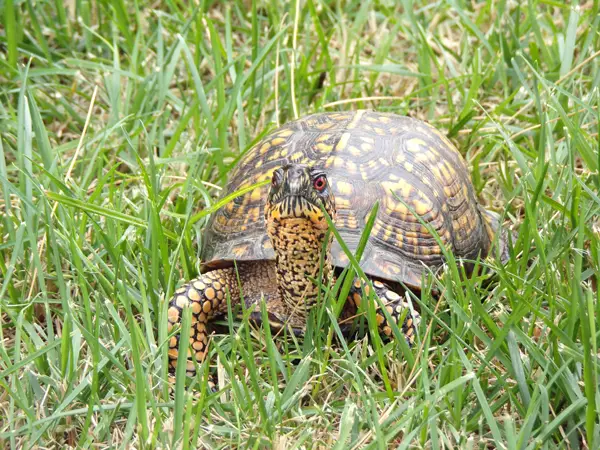
- Scientific name: Terrapene carolina
- Common name: Eastern Box Turtle, Land turtle, Box Turtle
- Family: Emydidae
- Size: 4.5 and 7 inches
- Lifespan: 50 to 100 years
- Conservation status: Vulnerable
The eastern box turtles are another popular choice for pet turtles due to their cute looks and easy-to-maintain nature. They tend to be shy and aren’t aggressive, so they’re friendly pets.
This turtle prefers a humid environment to ensure good respiratory health. in the wild, they usually inhabit dense thickets and woodland areas. They prefer these areas due to abundant access to sunlight and food sources nearby.
An adult turtle of this species is about 4.5 to 7 inches and weighs just 2lbs. It has a high, domed shell shape with a ridge running from head to toe. The shell of this turtle has varying colors of olive, brown, and tan.
The variation in markings on the shells of these turtles is so variable that you can’t easily recognize one by looking at the shell alone.
These eastern box turtles are omnivorous and feed on a variety of foods including insects, meat, fruits, vegetables, and various types of vegetation.
Note that eastern box turtles are taken from the wild for pet trade, leading to a decline in their population. For this reason, many states have illegalized capturing and selling of this species. You want to ensure the turtle is legal to keep as a pet in your state before owning one.
Conclusion
That’s it for our list of top 10 pet turtles that are cute and easier to take care of. These turtle species are friendly and not aggressive toward their owners. Their sizes range from small to fairly small, so you won’t need to worry about them getting too big that it gets hard to domesticate them.
All these pet turtles will live for several decades with good care and maintenance.
Note that some of these species are endangered or vulnerable and may be illegal to keep as pets in some states. As such, you’d want to first confirm with your state laws before keeping any of the above turtles as pets.
